结论 - 三星Galaxy A17 5G
Galaxy A17 5G 与前代产品Galaxy A16 5G 相比,更新幅度相对较小。尽管如此,它仍然是一款经济实惠、功能齐全的智能手机,非常适合日常使用。
三星立即限制了其六年更新一次的承诺,使其不再是一个承诺,而更像是一个目标,这有点令人讨厌。这样做也许有很好的理由,比如与未来Android 版本的驱动程序兼容性方面的不确定性,但它仍然给人留下了苦涩的回味。
坚固的机身给我们留下了深刻的印象,甚至还有大猩猩玻璃保护屏幕。三星还对重量和尺寸进行了一些调整,使手机比以前更加小巧。
为什么采用 Exynos SoC 的设备的电池续航时间总是比竞争对手的短,这是三星应该最终解开的一个谜。Galaxy A17 5G 的电池续航时间也比许多同类手机差。
对于日常使用来说,其性能是可以接受的,制造商也对功耗进行了一些优化。我们喜欢精确的定位和不错的扬声器音效。非常明亮的 AMOLED 屏幕也是该价位手机的一大卖点。
总的来说,Galaxy A17 5G 值得推荐。不过,您不应该过分依赖更新承诺。
Pros
Cons
价格和供应情况
这款手机已在许多零售商处有售,起价不到 230 美元。
这与亚马逊网站入门级(128GB 版本)智能手机的价格差不多。
从销售数据来看,很多人都拥有三星 A 系列智能手机。Galaxy A17 5G 可能又会特别受欢迎,因为它的价格也非常实惠:它采用了目前最快的移动网络标准,而且制造商承诺长期更新。
再加上简洁而合理的高品质外观,它一定会成为一款畅销产品,不是吗?那么,关于这款入门级手机的讨论点有很多,让我们开始详细分析吧。
规格
外壳 - 采用大猩猩玻璃,坚固耐用
Galaxy A17 5G 以圆角和磨砂背面呈现在买家面前。与上一代产品Galaxy A16 5G 不同的是,该机背面的相机镜头现在共用一个边框。
机身比前代产品略薄,重量也轻了几克。磨砂背面很容易留下指纹,在我们的深灰色机型上尤其明显。另外还有浅灰色和中蓝色可供选择。
外壳与去年相同,具有 IP54 防水防尘等级。这样就能很好地防止异物进入,但不要将手机浸入液体中。
机身非常稳定,没有任何吱吱作响或弯曲。总的来说,这款手机显得非常小巧耐用。与前代产品类似,该机正面安装了非常坚固的大猩猩 Victus 玻璃来保护屏幕。
» Notebookcheck多媒体笔记本电脑Top 10排名
» Notebookcheck游戏笔记本电脑Top 10排名
» Notebookcheck低价办公/商务笔记本电脑Top 10排名
» Notebookcheck高端办公/商务笔记本电脑Top 10排名
» Notebookcheck工作站笔记本电脑Top 10排名
» Notebookcheck亚笔记本电脑Top 10排名
» Notebookcheck超级本产品Top 10排名
» Notebookcheck变形本产品Top 10排名
» Notebookcheck平板电脑Top 10排名
» Notebookcheck智能手机Top 10排名
» Notebookcheck评测过最出色的笔记本电脑屏幕
» Notebookcheck售价500欧元以下笔记本电脑Top 10排名
» Notebookcheck售价300欧元以下笔记本电脑Top 10排名
功能 - 最好能有更多内存
microSD 读卡器
您也可以只插入一张 SIM 卡,另一个插槽则用于通过 microSD 卡扩展存储。实际上,三星在这里安装了一个速度相当快的读卡器,在我们使用参考 microSD 卡 Angelbird V60 进行的测试中就可以看到这一点。
| SD Card Reader - average JPG Copy Test (av. of 3 runs) | |
| Samsung Galaxy A16 5G (Angelbird AV Pro V60) | |
| Samsung Galaxy A17 5G (Angelbird V60) | |
| Xiaomi Redmi 14C (Angelbird V60) | |
| Average of class Smartphone (5.72 - 58.9, n=67, last 2 years) | |
| Xiaomi Redmi Note 14 5G (Angelbird AV Pro V60) | |
| Motorola Moto G15 (Angelbird V60) | |
跨平台磁盘测试 (CPDT)
软件 - 更新承诺听起来不错
可持续性
三星Galaxy A17 5G 的二氧化碳排放量数据不详。三星只报告了 1.2% 的可回收材料份额,而该手机只有 12.2% 的材料可回收。
三星Galaxy A17 5G 尚未出现在任何三星自修数据库中。因为这款手机还很新。
包装完全由纸张制成。
通信和全球导航卫星系统 - 5G 和速度一般的 Wi-Fi
Wi-Fi 5 再次成为最快的 Wi-Fi 标准,但遗憾的是,其数据传输速度与上一款智能手机的表现不尽相同。特别是在我们使用华硕 ROG Rapture AXE11000 路由器进行的测试中,我们发现速度明显下降,有时甚至低于 200 Mbps。这样的速度对于日常浏览来说还是足够稳定的,但如果有人想利用它的千兆性能,那就得另寻他处了。
本次评测涵盖的是Galaxy A17 的 5G 版本,但这款智能手机还配备了 4G 调制解调器和不同的 SoC。我们将很快对该机型进行评测。我们目前的评测设备有足够的 4G 和 5G 频段供在国外使用,但Galaxy A17 5G 并不是一款全球通用的手机。
与高端手机相比,接收能力通常较弱,尤其是在狭窄的小巷等恶劣环境中。
| Networking | |
| Samsung Galaxy A17 5G | |
| iperf3 transmit AXE11000 | |
| iperf3 receive AXE11000 | |
| Samsung Galaxy A16 5G | |
| iperf3 transmit AXE11000 | |
| iperf3 receive AXE11000 | |
| Motorola Moto G15 | |
| iperf3 transmit AXE11000 | |
| iperf3 receive AXE11000 | |
| Xiaomi Redmi 14C | |
| iperf3 transmit AXE11000 | |
| iperf3 receive AXE11000 | |
| Xiaomi Redmi Note 14 5G | |
| iperf3 transmit AXE11000 | |
| iperf3 receive AXE11000 | |
| Average 802.11 a/b/g/n/ac | |
| iperf3 transmit AXE11000 | |
| iperf3 receive AXE11000 | |
| Average of class Smartphone | |
| iperf3 transmit AXE11000 | |
| iperf3 receive AXE11000 | |
电话功能和语音质量 -Galaxy 电话让我们的声音被听到
只要你的手机供应商支持,你就可以在三星手机应用中启用 Wi-Fi 通话。VoLTE 可以在连接设置中找到。
为了测试Galaxy A17 5G 的语音质量,我们拨打了几次电话,发现我们的声音传输得相当清晰,而对方的声音听起来却有点闷。当我们激活免提麦克风和扬声器时,我们的声音仍然很容易被对方听懂,尽管通话者注意到有轻微的回声。
相机 - 物美价廉的镜头
与 A16 5G 相比,三星并没有改变摄像头的设置。 Galaxy A16 5G或 Galaxy A15 5G.但这并不是绝对必要的,因为售价不到 230 美元的Galaxy A17 依然配备了 5000 万像素的主镜头,在光线充足的环境下也能拍出不错的照片。
当然,就细节和动态范围而言,A17 的图像还无法与高端智能手机的摄像头相媲美。但色彩还原和清晰度却令人印象深刻。
视频最高可录制 1080p 和 30fps。自动对焦有时有些迟缓,但总体而言,图像质量还是不错的。
为了增加灵活性,还配备了 500 万像素超广角镜头和 200 万像素微距摄像头。不要指望这两个镜头能拍出极致的细节,因为它们的分辨率太低了。不同焦距之间也不能连续变焦,这意味着你只能手动切换。
前置摄像头的分辨率为 1300 万像素,自拍效果相当不错,不过细节可能有些模糊。
Image comparison
Choose a scene and navigate within the first image. One click changes the position on touchscreens. One click on the zoomed-in image opens the original in a new window. The first image shows the scaled photograph of the test device.
Main camera plantMain camera environmentMain camera low lightWide-angle camera乍看之下,在摄影棚的充足灯光下,主相机上的测试图表显得相当干净。细看之下,在棕色背景的衬托下,文字的边缘变得模糊不清。图像边缘的清晰度有所下降。
在 1 勒克斯条件下,主体仍然清晰可辨,但非常模糊。
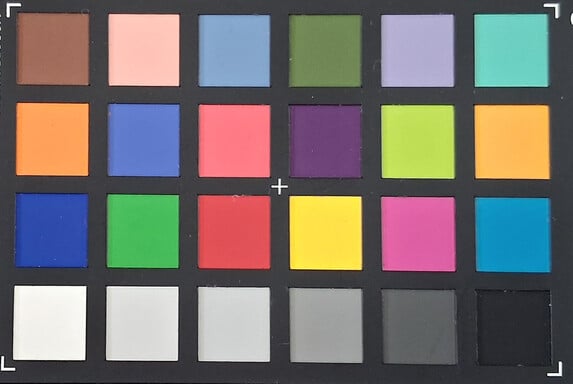
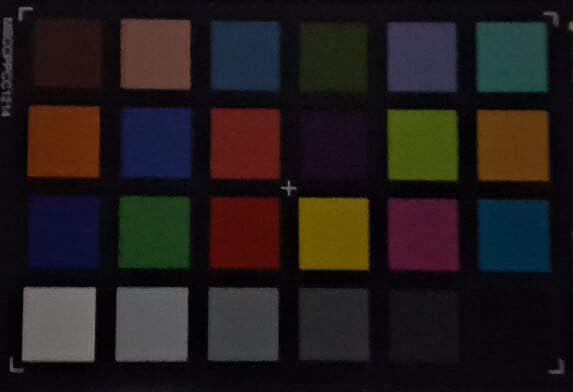
配件和保修 - 2 年放心保修
包装盒里除了手机外,只有一条 USB-C 数据线和一个 SIM 卡工具。
三星提供 24 个月的 保修期保修。
输入设备和操作 - 便捷的显示屏和得体的生物识别技术
显示屏 - AMOLED 是Galaxy 手机的一大亮点
| |||||||||||||||||||||||||
Brightness Distribution: 92 %
Center on Battery: 691 cd/m²
Contrast: ∞:1 (Black: 0 cd/m²)
ΔE ColorChecker Calman: 3.15 | ∀{0.5-29.43 Ø4.78}
ΔE Greyscale Calman: 3.6 | ∀{0.09-98 Ø5}
99.8% sRGB (Calman 2D)
Gamma: 2.041
CCT: 6507 K
| Samsung Galaxy A17 5G AMOLED, 2340x1080, 6.7" | Samsung Galaxy A16 5G Super AMOLED, 2340x1080, 6.7" | Motorola Moto G15 IPS, 2400x1080, 6.7" | Xiaomi Redmi 14C IPS, 1640x720, 6.9" | Xiaomi Redmi Note 14 5G AMOLED, 2400x1080, 6.7" | |
|---|---|---|---|---|---|
| Screen | 15% | -1% | -18% | 40% | |
| Brightness middle (cd/m²) | 691 | 739 7% | 468 -32% | 422 -39% | 1147 66% |
| Brightness (cd/m²) | 672 | 741 10% | 452 -33% | 401 -40% | 1146 71% |
| Brightness Distribution (%) | 92 | 97 5% | 86 -7% | 89 -3% | 96 4% |
| Black Level * (cd/m²) | 0.3 | 0.3 | |||
| Colorchecker dE 2000 * | 3.15 | 2.6 17% | 2.07 34% | 3.21 -2% | 1.6 49% |
| Colorchecker dE 2000 max. * | 4.41 | 3.8 14% | 6.38 -45% | 6.29 -43% | 3.7 16% |
| Greyscale dE 2000 * | 3.6 | 2.2 39% | 0.8 78% | 2.9 19% | 2.3 36% |
| Gamma | 2.041 108% | 2.04 108% | 2.202 100% | 2.382 92% | 2.27 97% |
| CCT | 6507 100% | 6327 103% | 6607 98% | 6338 103% | 6368 102% |
| Contrast (:1) | 1560 | 1407 |
* ... smaller is better
Screen Flickering / PWM (Pulse-Width Modulation)
| Screen flickering / PWM detected | 120 Hz Amplitude: 14 % | ||
The display backlight flickers at 120 Hz (worst case, e.g., utilizing PWM) . The frequency of 120 Hz is very low, so the flickering may cause eyestrain and headaches after extended use. In comparison: 53 % of all tested devices do not use PWM to dim the display. If PWM was detected, an average of 8108 (minimum: 5 - maximum: 343500) Hz was measured. | |||
以固定变焦水平和不同亮度设置进行的一系列测量(最低亮度下的振幅曲线看似平缓,但这是缩放造成的。最小亮度下的振幅放大图可在信息框中查看)。
Display Response Times
| ↔ Response Time Black to White | ||
|---|---|---|
| 19.4 ms ... rise ↗ and fall ↘ combined | ↗ 1.5 ms rise | |
| ↘ 17.9 ms fall | ||
| The screen shows good response rates in our tests, but may be too slow for competitive gamers. In comparison, all tested devices range from 0.1 (minimum) to 240 (maximum) ms. » 42 % of all devices are better. This means that the measured response time is similar to the average of all tested devices (20.2 ms). | ||
| ↔ Response Time 50% Grey to 80% Grey | ||
| 3.7 ms ... rise ↗ and fall ↘ combined | ↗ 1.8 ms rise | |
| ↘ 1.9 ms fall | ||
| The screen shows very fast response rates in our tests and should be very well suited for fast-paced gaming. In comparison, all tested devices range from 0.165 (minimum) to 636 (maximum) ms. » 14 % of all devices are better. This means that the measured response time is better than the average of all tested devices (31.6 ms). | ||
性能--新功能不多
与前代产品一样,Galaxy A17 5G 也采用了 Exynos 1330系统芯片。这次的基准测试结果略高,但这可能是软件优化的结果。
总的来说,对于这个价位的入门级手机来说,评测设备的运行速度很快,但在使用要求更高的应用程序时很快就会遇到问题。即使在日常使用中,浏览菜单或执行简单动画时也会偶尔出现卡顿。
人工智能计算的处理能力也相对有限。
| UL Procyon AI Inference for Android - Overall Score NNAPI | |
| Average of class Smartphone (3769 - 81594, n=135, last 2 years) | |
| Xiaomi Redmi Note 14 5G | |
| Samsung Galaxy A17 5G | |
| Average Samsung Exynos 1330 (5095 - 5194, n=2) | |
| Samsung Galaxy A16 5G | |
| Motorola Moto G15 | |
| AImark - Score v3.x | |
| Average of class Smartphone (82 - 307528, n=122, last 2 years) | |
| Xiaomi Redmi Note 14 5G | |
| Samsung Galaxy A17 5G | |
| Average Samsung Exynos 1330 (293 - 362, n=2) | |
| Samsung Galaxy A16 5G | |
| Geekbench AI | |
| Single Precision NPU 1.5 | |
| Average of class Smartphone (80 - 5210, n=59, last 2 years) | |
| Samsung Galaxy A17 5G | |
| Average Samsung Exynos 1330 (n=1) | |
| Half Precision NPU 1.5 | |
| Average of class Smartphone (80 - 36297, n=59, last 2 years) | |
| Samsung Galaxy A17 5G | |
| Average Samsung Exynos 1330 (n=1) | |
| Quantized NPU 1.5 | |
| Average of class Smartphone (133 - 49889, n=59, last 2 years) | |
| Samsung Galaxy A17 5G | |
| Average Samsung Exynos 1330 (n=1) | |
SoC 图形处理器的速度足以满足简单 3D 应用的需要,但更复杂的效果会对帧频造成很大影响。例如,在 GFXBench 中,只有简单的基准测试能以高于 30fps 的速度运行。
GFXBench (DX / GLBenchmark) 2.7: T-Rex Onscreen | 1920x1080 T-Rex Offscreen
GFXBench 3.0: on screen Manhattan Onscreen OGL | 1920x1080 1080p Manhattan Offscreen
GFXBench 3.1: on screen Manhattan ES 3.1 Onscreen | 1920x1080 Manhattan ES 3.1 Offscreen
GFXBench: on screen Car Chase Onscreen | 1920x1080 Car Chase Offscreen | on screen Aztec Ruins High Tier Onscreen | 2560x1440 Aztec Ruins High Tier Offscreen | on screen Aztec Ruins Normal Tier Onscreen | 1920x1080 Aztec Ruins Normal Tier Offscreen | 3840x2160 4K Aztec Ruins High Tier Offscreen
| 3DMark / Wild Life Extreme Unlimited | |
| Samsung Galaxy A16 5G | |
| Samsung Galaxy A17 5G | |
| Motorola Moto G15 | |
| Xiaomi Redmi 14C | |
| 3DMark / Wild Life Extreme | |
| Samsung Galaxy A17 5G | |
| Samsung Galaxy A16 5G | |
| Motorola Moto G15 | |
| Xiaomi Redmi 14C | |
| 3DMark / Wild Life Unlimited Score | |
| Samsung Galaxy A16 5G | |
| Samsung Galaxy A17 5G | |
| Motorola Moto G15 | |
| Xiaomi Redmi 14C | |
| 3DMark / Solar Bay Score | |
| Samsung Galaxy A16 5G | |
| 3DMark / Solar Bay Unlimited Score | |
| Samsung Galaxy A16 5G | |
| 3DMark / Steel Nomad Light Unlimited Score | |
| Samsung Galaxy A16 5G | |
| 3DMark / Steel Nomad Light Score | |
| Samsung Galaxy A16 5G | |
| GFXBench (DX / GLBenchmark) 2.7 / T-Rex Onscreen | |
| Xiaomi Redmi Note 14 5G | |
| Samsung Galaxy A16 5G | |
| Samsung Galaxy A17 5G | |
| Motorola Moto G15 | |
| GFXBench (DX / GLBenchmark) 2.7 / T-Rex Offscreen | |
| Xiaomi Redmi Note 14 5G | |
| Samsung Galaxy A16 5G | |
| Samsung Galaxy A17 5G | |
| Motorola Moto G15 | |
| GFXBench 3.0 / Manhattan Onscreen OGL | |
| Xiaomi Redmi Note 14 5G | |
| Samsung Galaxy A16 5G | |
| Samsung Galaxy A17 5G | |
| Motorola Moto G15 | |
| GFXBench 3.0 / 1080p Manhattan Offscreen | |
| Xiaomi Redmi Note 14 5G | |
| Samsung Galaxy A16 5G | |
| Samsung Galaxy A17 5G | |
| Motorola Moto G15 | |
| GFXBench 3.1 / Manhattan ES 3.1 Onscreen | |
| Xiaomi Redmi Note 14 5G | |
| Samsung Galaxy A16 5G | |
| Samsung Galaxy A17 5G | |
| Motorola Moto G15 | |
| GFXBench 3.1 / Manhattan ES 3.1 Offscreen | |
| Xiaomi Redmi Note 14 5G | |
| Samsung Galaxy A16 5G | |
| Samsung Galaxy A17 5G | |
| Motorola Moto G15 | |
| GFXBench / Car Chase Onscreen | |
| Xiaomi Redmi Note 14 5G | |
| Samsung Galaxy A16 5G | |
| Samsung Galaxy A17 5G | |
| Motorola Moto G15 | |
| GFXBench / Car Chase Offscreen | |
| Xiaomi Redmi Note 14 5G | |
| Samsung Galaxy A16 5G | |
| Samsung Galaxy A17 5G | |
| Motorola Moto G15 | |
| GFXBench / Aztec Ruins High Tier Onscreen | |
| Xiaomi Redmi Note 14 5G | |
| Samsung Galaxy A16 5G | |
| Samsung Galaxy A17 5G | |
| Xiaomi Redmi 14C | |
| Motorola Moto G15 | |
| GFXBench / Aztec Ruins High Tier Offscreen | |
| Xiaomi Redmi Note 14 5G | |
| Samsung Galaxy A16 5G | |
| Samsung Galaxy A17 5G | |
| Xiaomi Redmi 14C | |
| Motorola Moto G15 | |
| GFXBench / Aztec Ruins Normal Tier Onscreen | |
| Xiaomi Redmi Note 14 5G | |
| Samsung Galaxy A16 5G | |
| Samsung Galaxy A17 5G | |
| Xiaomi Redmi 14C | |
| Motorola Moto G15 | |
| GFXBench / Aztec Ruins Normal Tier Offscreen | |
| Xiaomi Redmi Note 14 5G | |
| Samsung Galaxy A16 5G | |
| Samsung Galaxy A17 5G | |
| Xiaomi Redmi 14C | |
| Motorola Moto G15 | |
| GFXBench / 4K Aztec Ruins High Tier Offscreen | |
| Xiaomi Redmi Note 14 5G | |
| Samsung Galaxy A16 5G | |
| Samsung Galaxy A17 5G | |
| Motorola Moto G15 | |
| Xiaomi Redmi 14C | |
虽然在Galaxy A17 5G 上浏览互联网有时会感觉有点慢,但其他入门级手机有时会慢很多。
| Jetstream 2 - 2.0 Total Score | |
| Average of class Smartphone (23.8 - 387, n=149, last 2 years) | |
| Xiaomi Redmi Note 14 5G (Chrome 133.0.6943.49) | |
| Samsung Galaxy A16 5G (Chrome 131.0.6778.200) | |
| Average Samsung Exynos 1330 (97.7 - 99.8, n=2) | |
| Samsung Galaxy A17 5G (Chrome 140) | |
| Speedometer 2.0 - Result 2.0 | |
| Average of class Smartphone (15.2 - 643, n=122, last 2 years) | |
| Samsung Galaxy A17 5G (Chrome 140) | |
| Xiaomi Redmi Note 14 5G (Chrome 133.0.6943.49) | |
| Average Samsung Exynos 1330 (87.6 - 114, n=2) | |
| Samsung Galaxy A16 5G (Chrome 131.0.6778.200) | |
| Motorola Moto G15 (Chrome 134) | |
| Speedometer 3 - Score 3.0 | |
| Average of class Smartphone (1.03 - 42.8, n=124, last 2 years) | |
| Samsung Galaxy A17 5G (Chrome 140) | |
| Xiaomi Redmi Note 14 5G (Chrome 133.0.6943.49) | |
| Average Samsung Exynos 1330 (4.98 - 7.07, n=2) | |
| Samsung Galaxy A16 5G (Chrome 131.0.6778.200) | |
| Motorola Moto G15 (Chrome 134) | |
| WebXPRT 4 - Overall | |
| Average of class Smartphone (27 - 306, n=145, last 2 years) | |
| Xiaomi Redmi Note 14 5G (Chrome 133.0.6943.49) | |
| Samsung Galaxy A16 5G (Chrome 131.0.6778.200) | |
| Average Samsung Exynos 1330 (102 - 109, n=2) | |
| Samsung Galaxy A17 5G (Chrome 140) | |
| Motorola Moto G15 (Chrome 134) | |
| Octane V2 - Total Score | |
| Average of class Smartphone (2228 - 121337, n=197, last 2 years) | |
| Xiaomi Redmi Note 14 5G (Chrome 133.0.6943.49) | |
| Samsung Galaxy A16 5G (Chrome 131.0.6778.200) | |
| Average Samsung Exynos 1330 (30119 - 33085, n=2) | |
| Samsung Galaxy A17 5G (Chrome 140) | |
| Motorola Moto G15 (Chrome 134) | |
| Xiaomi Redmi 14C (Chrome 131) | |
| Mozilla Kraken 1.1 - Total | |
| Motorola Moto G15 (Chrome 134) | |
| Samsung Galaxy A16 5G (Chrome 131.0.6778.200) | |
| Average of class Smartphone (257 - 28190, n=153, last 2 years) | |
| Xiaomi Redmi Note 14 5G (Chrome 133.0.6943.49) | |
| Average Samsung Exynos 1330 (1055 - 1184, n=2) | |
| Samsung Galaxy A17 5G (Chrome 140) | |
* ... smaller is better
UFS 2.2 存储确保了合理的加载时间,也在一定程度上加快了数据传输的速度。
不过,必须指出的是,前代产品的存储控制器做得更好。
| Samsung Galaxy A17 5G | Samsung Galaxy A16 5G | Motorola Moto G15 | Xiaomi Redmi 14C | Xiaomi Redmi Note 14 5G | Average 128 GB eMMC Flash | Average of class Smartphone | |
|---|---|---|---|---|---|---|---|
| AndroBench 3-5 | 31% | -2% | -6% | 218% | -16% | 477% | |
| Sequential Read 256KB (MB/s) | 528.2 | 529.46 0% | 287.7 -46% | 300.9 -43% | 950.62 80% | 300 ? -43% | 2217 ? 320% |
| Sequential Write 256KB (MB/s) | 170.7 | 273.75 60% | 228.5 34% | 193.1 13% | 792.56 364% | 195.1 ? 14% | 1840 ? 978% |
| Random Read 4KB (MB/s) | 134.7 | 206.73 53% | 65.2 -52% | 88.6 -34% | 257.91 91% | 85.9 ? -36% | 294 ? 118% |
| Random Write 4KB (MB/s) | 56.4 | 62.47 11% | 87.4 55% | 78.9 40% | 245.16 335% | 58.1 ? 3% | 334 ? 492% |
游戏 - 小规模游戏
三星Galaxy A17 5G 无法满足任何喜欢高要求游戏的用户的需求。
虽然性能足以满足图形简单的休闲游戏,但我们的测试游戏《玄心冲击》和《PUBG Mobile》只能达到 30-40fps 左右,即使如此,也会出现掉帧和卡顿现象。
我们使用GameBench软件进行测量。
排放 - 保持凉爽,几乎不节流
温度
机箱表面产生的热量不成问题,即使在负载情况下,温度也能达到 43.8°C。
3DMark 压力测试表明,系统在长时间负载运行时不需要节流,就能将内部温度控制在可接受的水平。
(±) The maximum temperature on the upper side is 43.8 °C / 111 F, compared to the average of 35.2 °C / 95 F, ranging from 21.9 to 247 °C for the class Smartphone.
(±) The bottom heats up to a maximum of 44.7 °C / 112 F, compared to the average of 34 °C / 93 F
(+) In idle usage, the average temperature for the upper side is 23.2 °C / 74 F, compared to the device average of 32.9 °C / 91 F.
3DMark 压力测试
| 3DMark | |
| Wild Life Stress Test Stability | |
| Samsung Galaxy A16 5G | |
| Motorola Moto G15 | |
| Samsung Galaxy A17 5G | |
| Xiaomi Redmi 14C | |
| Wild Life Extreme Stress Test | |
| Samsung Galaxy A16 5G | |
| Motorola Moto G15 | |
| Xiaomi Redmi 14C | |
| Samsung Galaxy A17 5G | |
| Steel Nomad Light Stress Test Stability | |
| Samsung Galaxy A16 5G | |
发言人
您只能使用底部边缘的一个扬声器。虽然它的音量很大,但听起来总是有点高音偏重。
不过,音质还是可以接受的,尤其是对于这样一款廉价智能手机来说。即使在最大音量时,扬声器也不会出现卡壳现象。
外部音频设备可通过 USB-C 或蓝牙连接。可用于无线传输的编解码器包括 SBC、AAC、aptX、LDAC 和三星无缝编解码器 (SSC),但其他智能手机可提供更多选择。
Samsung Galaxy A17 5G audio analysis
(+) | speakers can play relatively loud (89.2 dB)
Bass 100 - 315 Hz
(-) | nearly no bass - on average 24.6% lower than median
(±) | linearity of bass is average (13.5% delta to prev. frequency)
Mids 400 - 2000 Hz
(±) | higher mids - on average 7.6% higher than median
(+) | mids are linear (6.9% delta to prev. frequency)
Highs 2 - 16 kHz
(±) | higher highs - on average 7% higher than median
(±) | linearity of highs is average (7.9% delta to prev. frequency)
Overall 100 - 16.000 Hz
(±) | linearity of overall sound is average (22.9% difference to median)
Compared to same class
» 50% of all tested devices in this class were better, 7% similar, 43% worse
» The best had a delta of 11%, average was 35%, worst was 134%
Compared to all devices tested
» 67% of all tested devices were better, 6% similar, 27% worse
» The best had a delta of 4%, average was 24%, worst was 134%
Xiaomi Redmi Note 14 5G audio analysis
(+) | speakers can play relatively loud (91.5 dB)
Bass 100 - 315 Hz
(-) | nearly no bass - on average 24.4% lower than median
(+) | bass is linear (3.7% delta to prev. frequency)
Mids 400 - 2000 Hz
(±) | higher mids - on average 8.7% higher than median
(±) | linearity of mids is average (7.6% delta to prev. frequency)
Highs 2 - 16 kHz
(+) | balanced highs - only 3.9% away from median
(+) | highs are linear (4.7% delta to prev. frequency)
Overall 100 - 16.000 Hz
(±) | linearity of overall sound is average (19.1% difference to median)
Compared to same class
» 24% of all tested devices in this class were better, 9% similar, 67% worse
» The best had a delta of 11%, average was 35%, worst was 134%
Compared to all devices tested
» 45% of all tested devices were better, 7% similar, 48% worse
» The best had a delta of 4%, average was 24%, worst was 134%
电池续航时间 - 可以做得更好
耗电量
在我们的功耗测试中,Galaxy A17 5G 与前代产品相比显示出明显不同的能耗偏好:最低功耗仍然相当接近,但在空闲模式下,当前机型与 A16 5G 相比明显更加经济。 Galaxy A16 5G.
不过,在负载模式下,要想提供良好的性能,所需的功耗要稍高一些。
看来,三星在此方面进行了改进,以便在轻负载下优化功耗的同时,让 SoC 的性能更高一些。
| Off / Standby | |
| Idle | |
| Load |
|
Key:
min: | |
| Samsung Galaxy A17 5G 5000 mAh | Samsung Galaxy A16 5G 5000 mAh | Motorola Moto G15 5200 mAh | Xiaomi Redmi 14C 5160 mAh | Xiaomi Redmi Note 14 5G 5110 mAh | Average Samsung Exynos 1330 | Average of class Smartphone | |
|---|---|---|---|---|---|---|---|
| Power Consumption | -14% | 8% | -1% | -7% | -16% | ||
| Idle Minimum * (Watt) | 1 | 1.19 -19% | 0.6 40% | 1.15 -15% | 1.095 ? -10% | 0.842 ? 16% | |
| Idle Average * (Watt) | 1.3 | 2.14 -65% | 1.3 -0% | 1.55 -19% | 1.72 ? -32% | 1.439 ? -11% | |
| Idle Maximum * (Watt) | 1.6 | 2.17 -36% | 1.6 -0% | 1.57 2% | 1.885 ? -18% | 1.624 ? -2% | |
| Load Average * (Watt) | 4.9 | 3.11 37% | 4.7 4% | 3.87 21% | 4.01 ? 18% | 7.03 ? -43% | |
| Load Maximum * (Watt) | 8.1 | 7.15 12% | 8.5 -5% | 7.66 5% | 7.63 ? 6% | 11.3 ? -40% |
* ... smaller is better
功耗:Geekbench (150 cd/m²)
功耗:GFXbench (150 cd/m²)
电池寿命
总体而言,三星Galaxy A17 5G 的 5,000 毫安时电池续航能力也比较一般。13 小时 14 分钟的 Wi-Fi 上网时间比上一代产品要长,但同时与其他入门级智能手机相比也相对较短。
在游戏等负载情况下,电池续航时间为 4 小时 30 分钟。
电池充电功率可达 25 瓦。这意味着一个完整的充电周期大约需要 1 小时 30 分钟。
我们的评测设备没有配备充电器,但Galaxy A17 5G 电池可以用我们测试的所有充电器轻松充满。
| Samsung Galaxy A17 5G 5000 mAh | Samsung Galaxy A16 5G 5000 mAh | Motorola Moto G15 5200 mAh | Xiaomi Redmi 14C 5160 mAh | Xiaomi Redmi Note 14 5G 5110 mAh | |
|---|---|---|---|---|---|
| Battery runtime | -1% | 13% | 23% | 4% | |
| Reader / Idle (h) | 33.7 | 34.5 2% | 29.8 -12% | 30 -11% | |
| H.264 (h) | 17.9 | 18.7 4% | 19.8 11% | 17 -5% | |
| WiFi v1.3 (h) | 13.2 | 12.4 -6% | 17 29% | 16.3 23% | 12.9 -2% |
| Load (h) | 4.5 | 4.4 -2% | 5.5 22% | 6 33% |
Notebookcheck 总体评分
从纸面上看,三星Galaxy A17 5G 拥有六年更新的巨大承诺,但遗憾的是,制造商的措辞在一定程度上限制了这一点。
不过,从本质上讲,这款手机是一款具有不错功能的高品质入门级手机。
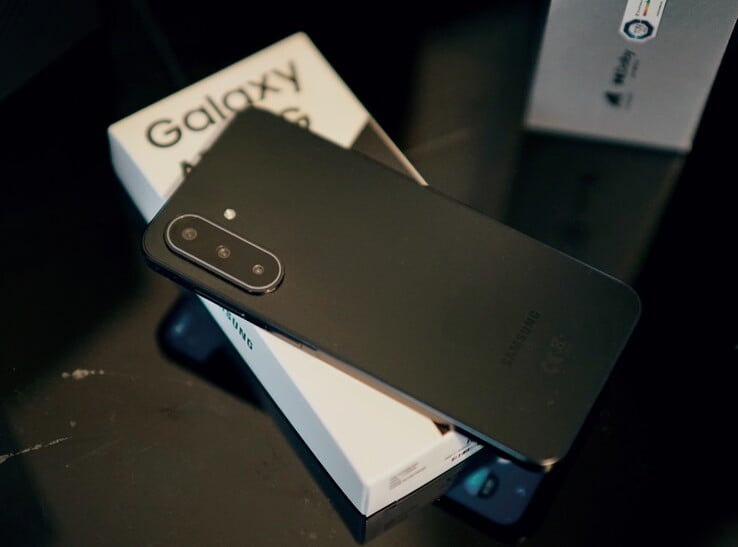
Samsung Galaxy A17 5G
- 09/25/2025 v8
Florian Schmitt
可能的替代品比较
Image | Model / Review | Price | Weight | Drive | Display |
|---|---|---|---|---|---|
| Samsung Galaxy A17 5G Samsung Exynos 1330 ⎘ ARM Mali-G68 MP2 ⎘ 4 GB Memory, 128 GB eMMC | Amazon: $212.99 List Price: 209€ | 192 g | 128 GB eMMC Flash | 6.70" 2340x1080 385 PPI AMOLED | |
| Samsung Galaxy A16 5G Samsung Exynos 1330 ⎘ ARM Mali-G68 MP2 ⎘ 4 GB Memory, 128 GB UFS 2.1 | Amazon: List Price: 200€ | 200 g | 128 GB UFS 2.2 Flash | 6.70" 2340x1080 385 PPI Super AMOLED | |
| Motorola Moto G15 Mediatek Helio G81 ⎘ ARM Mali-G52 MP2 ⎘ 4 GB Memory, 128 GB eMMC | Amazon: $130.00 List Price: 150€ | 190 g | 128 GB eMMC Flash | 6.72" 2400x1080 392 PPI IPS | |
| Xiaomi Redmi 14C Mediatek Helio G81 Ultra ⎘ ARM Mali-G52 MP2 ⎘ 4 GB Memory, 128 GB eMMC | Amazon: List Price: 150€ | 211 g | 128 GB eMMC Flash | 6.88" 1640x720 260 PPI IPS | |
| Xiaomi Redmi Note 14 5G MediaTek Dimensity 7025 ⎘ IMG BXM-8-256 ⎘ 8 GB Memory, 256 GB UFS 2.1 | Amazon: 1. $299.99 XIAOMI Redmi Note 14 5G + LT... 2. $348.00 XIAOMI Redmi Note 14 Pro+ Pl... 3. $191.50 Xiaomi Redmi Note 14 4G LTE ... | 190 g | 256 GB UFS 2.2 Flash | 6.67" 2400x1080 395 PPI AMOLED |
Transparency
The selection of devices to be reviewed is made by our editorial team. The test sample was provided to the author as a loan by the manufacturer or retailer for the purpose of this review. The lender had no influence on this review, nor did the manufacturer receive a copy of this review before publication. There was no obligation to publish this review. As an independent media company, Notebookcheck is not subjected to the authority of manufacturers, retailers or publishers.
This is how Notebookcheck is testing
Every year, Notebookcheck independently reviews hundreds of laptops and smartphones using standardized procedures to ensure that all results are comparable. We have continuously developed our test methods for around 20 years and set industry standards in the process. In our test labs, high-quality measuring equipment is utilized by experienced technicians and editors. These tests involve a multi-stage validation process. Our complex rating system is based on hundreds of well-founded measurements and benchmarks, which maintains objectivity. Further information on our test methods can be found here.






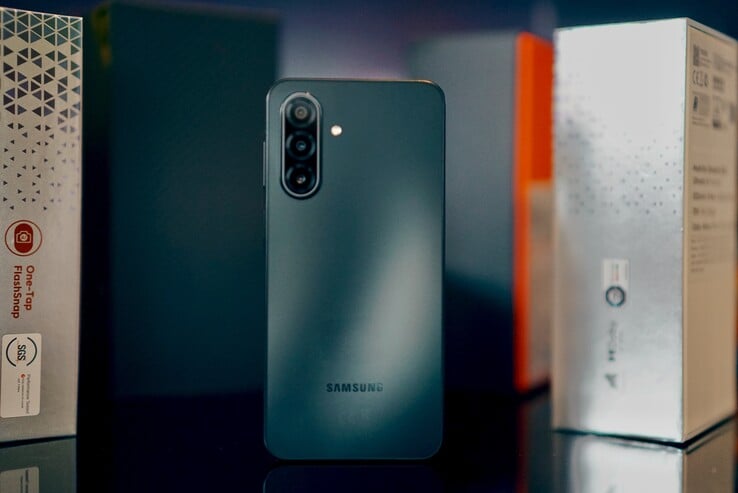








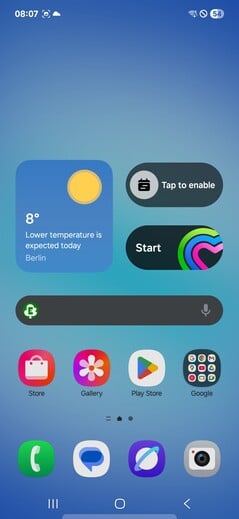


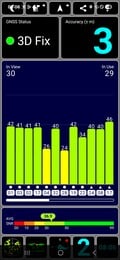
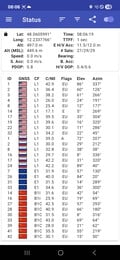
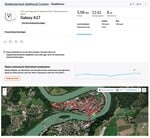
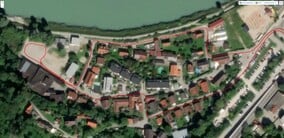

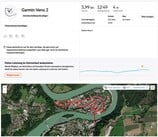




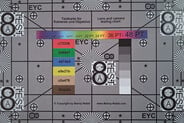

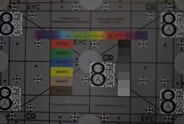

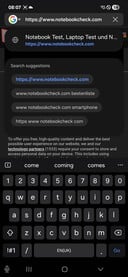
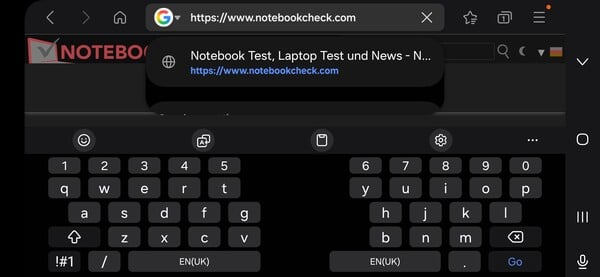

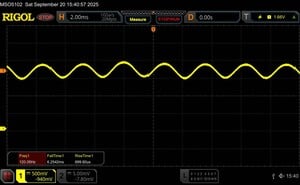





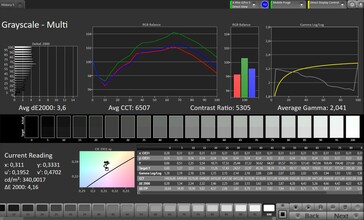
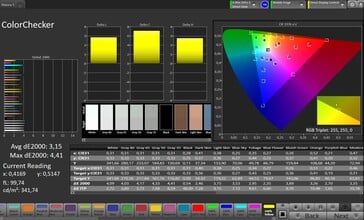
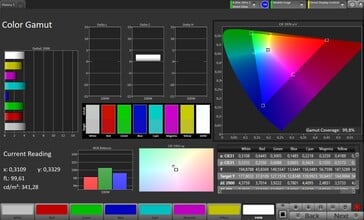
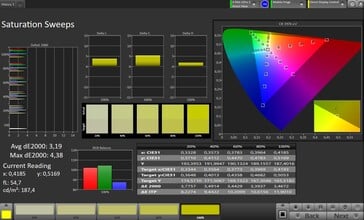
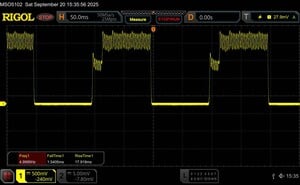
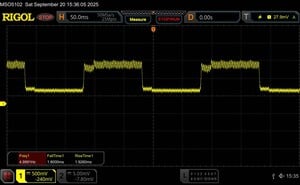
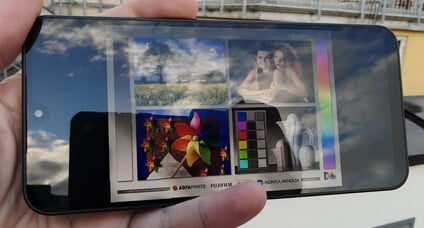



 Total Sustainability Score:
Total Sustainability Score: 





